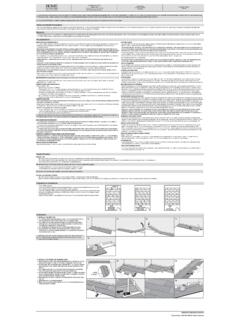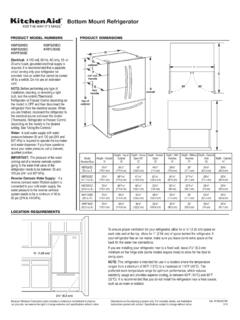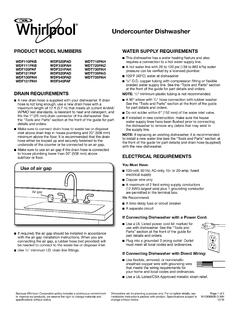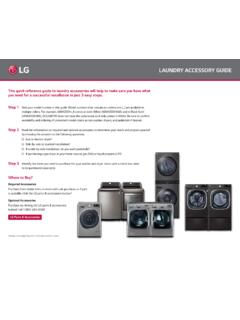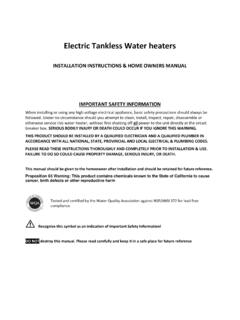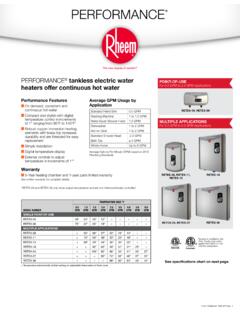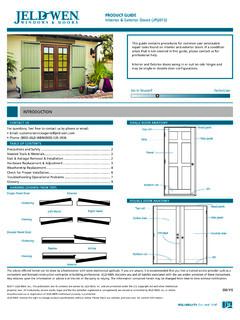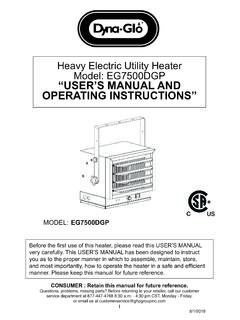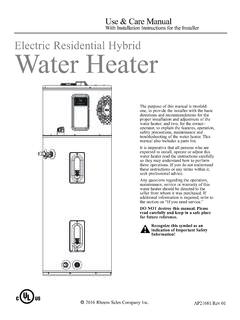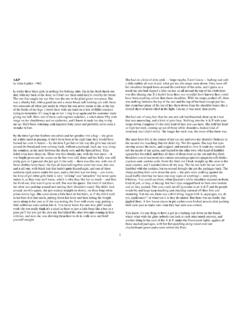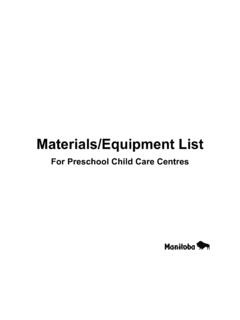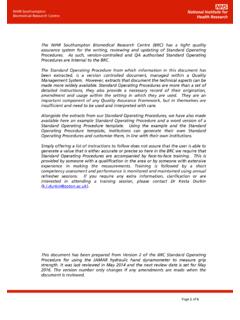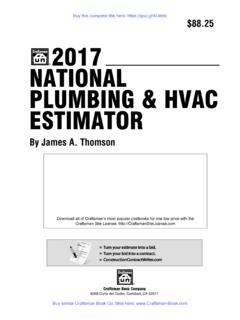Transcription of MOHAWK RESIDENTIAL INSTALLATION GUIDE -SHEET …
1 MOHAWK RESIDENTIAL INSTALLATION GUIDE . - sheet VINYL FLOORING. There are three methods of INSTALLATION suitable for MOHAWK RESIDENTIAL sheet vinyl flooring: The INSTALLATION method used is dependent upon the day-to-day activities and the overall floor dimensions. 1. Releasable Full Spread INSTALLATION Method using Pressure Sensitive Adhesive (most common). 2. Loose-Lay INSTALLATION (in areas 25 square yards or less and no more than 1 seam). 3. Permanent Full Spread INSTALLATION Method NOTE: This method must be used for all Specialty Retail and ADA compliant installations as well as any areas requiring rolling loads. Releasable Full Spread INSTALLATION Method using Pressure Sensitive Adhesive Materials Required for INSTALLATION : 3/8 short nap paint roller Roberts 2310 Pressure Sensitive Releasable Adhesive Roberts 7500 Universal Seam Sealant Acrylic Double Face Tape for Vinyl Floors Sharp Utility Knife Straight edge Push broom Henry 336 Primer (if priming the substrate is necessary).
2 Acceptable Underlayment: Wood Underlayment Wood underlayment panels require a double layer construction and must be underlayment grade as specified and warranted by the manufacturer. Always fasten underlayment panels in accordance with the manufacturer's recommendations. Any failure of the underlayment or flooring as a result of the underlayment is NOT the responsibility of MOHAWK . Any porous wood underlayment must be primed. The following are acceptable forms of underlayment: Concrete VCT (well bonded, on and above grade) with all existing wax removed Ceramic (well bonded) with a skim coat Terrazzo (well bonded). Self-leveling and patching compounds (latex fortified Portland cement based only). Resilient floor (no more than 2 layers, well bonded, non-cushioned RESIDENTIAL applications only) all wax removed Radiant heat floors (not exceeding 85 F [29 C] and approved by the manufacturer for the use of their product with resilient vinyl flooring applications).
3 Gypcrete can be utilized when necessary due to radiant heat and in high rise buildings. Gypcrete must be sealed using Henry 336 Primer to stabilize the surface for adhesive bond. All issues with gypcrete cracking, crumbling, powdering and any other issues resulting in the release of adhesive bond are NOT warranted by MOHAWK . OSB (underlayment grade). OSB underlayment panels must be underlayment grade as specified and warranted by the manufacturer. Underlayment panels and joints must be fastened and reinforced according to manufacturer's instructions. Completely sand the floor with a floor sander, so that the floor is smooth and flat. Note: The chips in OSB overlap. Without sanding properly, OSB has high and low spots throughout the floor that could telegraph through the vinyl. Surface must be primed using Henry 336 Primer.
4 Particle board (underlayment grade). Particle board underlayment panels must be underlayment grade as specified and warranted by the manufacturer. Surface must be primed using Henry 336 Primer. MOHAWK TECHNICAL SERVICES HARD SURFACE | | 1687_2020 | ES | 10/2020 | 1 of 8. floor Preparation: floor must be clean, smooth, flat and dry. Remove all foreign substances such as wax, grease, dirt, construction markings and contaminants, and any substance or chemical that would interfere with a good bond. Fill all holes and cracks with a latex fortified Portland cement-based patching compound. Sand high spots to eliminate the possibility of telegraphing. Prime floor if needed with Henry 336 Primer to prevent over absorption of adhesives and to ensure a better bond of the adhesive to the subfloor.
5 Moisture levels at the time of INSTALLATION of concrete slabs during and after INSTALLATION must be 5 lbs. or less per 1000 square feet per 24 hours using an anhydrous calcium chloride test according to ASTM F-1869, and pH must be between 5 and 9; or, if using ASTM F-2170 In-Situ Probes should be less than 75%. relative humidity. Inspection of flooring material prior to INSTALLATION is required. Any defects should be immediately reported to the retail store from which the flooring was purchased before INSTALLATION . MOHAWK will not be responsible for labor costs to repair or replace material with defects that were apparent before or noticed at the end of an INSTALLATION . The job site and all flooring material and adhesive must be kept between 65 F and 85 F (18 C and 29 C) for 24 hours before, during and after INSTALLATION .
6 Releasable INSTALLATION Method using Pressure Sensitive Adhesive Steps Step 1. Prepare substrate surface to be clean, smooth, flat and dry. Under cut all wooden door jambs to maintain a 1/8 relief gap. Step 2. Place acrylic double face tape at all doorways where a transition strip is needed, next to sliding doors, in front of tubs and shower stalls, and similar areas where an expansion gap will not be covered with trim. Place double face acrylic tape around all floor vents to eliminate air migrating under vinyl causing bubbles. Do not tape along walls or around perimeter of room, as this is not perimeter install flooring. Step 3. Align the pattern with the most dominant wall to achieve the best appearance in the room. Using a sharp utility knife, trim away excess material along the walls, at cabinets, etc.
7 , leaving approximately 2 of vinyl at these areas to be trimmed off later (rough cut). Never install cabinets on top of sheet goods installed with releasable adhesive. Step 4. IF A SEAM IS REQUIRED, PLEASE FOLLOW THE SEAMING INSTRUCTIONS IN A RELEASEABLE FULL SPREAD INSTALLATION METHOD WITH PRESSURE. SENSITIVE ADHESIVE.. Step 5. Make relief cuts at corners and projections to allow the material to lay flat before the final cuts are made. Final trimming should be done by cutting in with a utility knife or trimmer, leaving a 1/8 to 1/4 expansion gap. The gap allows for sub- floor movement caused by changes in atmospheric conditions. The material should not touch the wall, corners or objects at any point or bubbles or wrinkles may occur. The material must lay flat to stay flat. Final cuts must be made prior to applying adhesive.
8 Step 6. Fold back material one half at a time and roll on a consistent layer of 2310 Pressure Sensitive Releasable Adhesive with the 3/8 short nap paint roller or trowel with 1/16 x1/32 x1/32 U notch trowel. Step 7. Before placing the material in the adhesive, make sure the adhesive is completely dry (must be dry and tacky to the touch). There should be no transfer of adhesive to material. (A fan can be used to accelerate drying time.) If the adhesive is not completely dry before INSTALLATION of material, the adhesive will continue to release gasses causing bubbles under the vinyl material. Step 8. Position the material in place so that no shifting can occur. Do not lift the vinyl into place because it may shift slightly and wrinkle. Step 9. Starting in the center of the floor , remove air from under material using a push broom (broom method).
9 Do not use any type of heavy flooring roller, 75 or 100. pound. Do not twist material when placing it onto the adhesive. Step 10. Repeat steps 6-8 for the remaining portion of the flooring material. Step 11. Use quarter round or base board to cover the exposed expansion gap. When installing quarter round or any moldings, make sure that they are fastened only to the wall, and do not pinch the material at any point. * Material not installed in accordance with MOHAWK recommended guidelines, including all problems caused by the use of non-recommended adhesive, seam sealer, underlayment and/or improper preparation of the substrate are not covered under the MOHAWK warranty. MOHAWK TECHNICAL SERVICES HARD SURFACE | | 1687_2020 | ES | 10/2020 | 2 of 8. Seaming Instructions in a Releasable Full Spread INSTALLATION Method using Pressure Sensitive Adhesive 1.
10 After adhesive is rolled on and completely dry, position the flooring by over-lapping the seam edges. (Make sure to match patterns.). 2. With a straight edge and a sharp utility knife, cut through both layers of flooring material (double-cut) at the designated match point. Make sure the utility knife blade is held in an upright position for a clean 90 degree cut. 3. Remove and discard waste material. 4. Fold back about 8 of the vinyl on one side of the seam and apply a small bead of 7500 Seam Sealant to one edge of the vinyl that is on the floor . 5. Tuck the seam edges together and wipe off excess bond/sealer with a clean, damp cloth. 6. Use a resilient flooring type hand roller (or wallpaper seam roller) to squeeze out any remaining sealer from the seam. Immediately clean seam with a damp cloth followed by a clean, dry cloth.
